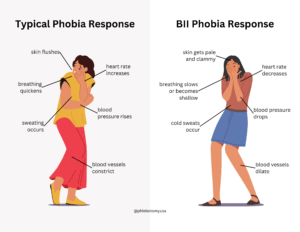11 Dec Why People Faint at the Sight of Blood
Many might think fainting at the sight of blood is a mere overreaction, but in reality, it’s a real phobia. This condition, known as Blood-injury-injection (BII) phobia, involves more than just an emotional response; it can cause a physical reaction, including fainting. Let’s dive into the nature of BII phobia to understand this intriguing condition better.
What is BII Phobia?
Blood-injury-injection phobia is a type of anxiety disorder known by an intense fear of blood, injury, or injections. This phobia has a lot to do with vasovagal syncope, a reflex that leads to fainting or near-fainting episodes. It’s estimated that BII affects about 3-15% of the population. However, getting accurate stats for this phobia is tricky. Many individuals with this condition tend to avoid healthcare settings where their condition would be recorded.
Triggers
The triggers of BII are pretty specific:
- Blood
- Needles
- Medical procedures
- Watching others experience pain
For some, even the thought or discussion of these subjects can induce a response. The severity of the reaction can vary significantly among individuals, from mild discomfort to severe anxiety and physical symptoms.
How BII Differs from Other Phobias
BII phobia stands out from other phobias in several ways. Most phobias, like fear of heights or spiders, increase heart rate as part of the body’s “fight or flight” response. However, the heart rate and blood pressure drop in BII, resulting in dizziness or fainting. Additionally, while fear is a component in all phobias, disgust plays a significant role in BII. Sometimes, it is even more prevalent than fear itself.
Risk Factors
The danger of BII lies in its physical reactions. The sudden drop in blood pressure and heart rate can lead to fainting, posing the risk of injuries. Moreover, the phobia can stop individuals from seeking necessary medical care, like vaccinations and blood tests, due to the fear of encountering their triggers.
Treatment Through Therapy
One approach to managing BII is through therapy, particularly cognitive-behavioral therapy and exposure therapy. These therapies involve slowly exposing the individual to their phobia triggers in a controlled environment. Therapists also teach techniques to help the fainting response, such as tensing the muscles to help maintain blood pressure.
Conclusion
In conclusion, Blood-injury-injection phobia is a complex condition that requires an understanding of its physical and mental aspects. Recognizing the triggers and symptoms is crucial for those affected. With proper therapy and coping strategies, individuals can learn to manage their phobia. This can significantly reduce both the distress and the risks associated with it. For anyone struggling with BII phobia, seeking professional help is a critical step toward overcoming the challenges posed by this unique condition.


